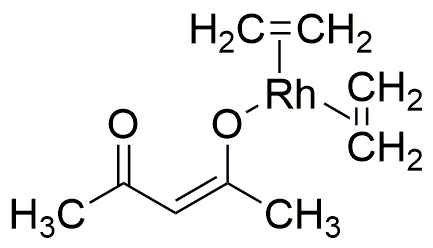Acetylacetonatobis(ethylene)rhodium(I) is widely utilized in research focused on:
- Catalysis: This compound is an effective catalyst in various organic reactions, particularly in hydrogenation processes, which are crucial in the production of fine chemicals and pharmaceuticals.
- Organometallic Chemistry: It serves as a key reagent in the synthesis of organometallic compounds, aiding researchers in developing new materials and chemical processes.
- Environmental Applications: Its catalytic properties are leveraged in environmental chemistry to facilitate the breakdown of pollutants, contributing to cleaner industrial processes.
- Material Science: Used in the development of advanced materials, this compound helps in creating polymers with enhanced properties, beneficial for industries like electronics and coatings.
- Pharmaceutical Development: The compound plays a role in drug synthesis, particularly in creating complex molecules that are essential for new therapeutic agents.
General Information
Properties
Safety and Regulations
Applications
Acetylacetonatobis(ethylene)rhodium(I) is widely utilized in research focused on:
- Catalysis: This compound is an effective catalyst in various organic reactions, particularly in hydrogenation processes, which are crucial in the production of fine chemicals and pharmaceuticals.
- Organometallic Chemistry: It serves as a key reagent in the synthesis of organometallic compounds, aiding researchers in developing new materials and chemical processes.
- Environmental Applications: Its catalytic properties are leveraged in environmental chemistry to facilitate the breakdown of pollutants, contributing to cleaner industrial processes.
- Material Science: Used in the development of advanced materials, this compound helps in creating polymers with enhanced properties, beneficial for industries like electronics and coatings.
- Pharmaceutical Development: The compound plays a role in drug synthesis, particularly in creating complex molecules that are essential for new therapeutic agents.
Documents
Safety Data Sheets (SDS)
The SDS provides comprehensive safety information on handling, storage, and disposal of the product.
Product Specification (PS)
The PS provides a comprehensive breakdown of the product’s properties, including chemical composition, physical state, purity, and storage requirements. It also details acceptable quality ranges and the product's intended applications.
Certificates of Analysis (COA)
Search for Certificates of Analysis (COA) by entering the products Lot Number. Lot and Batch Numbers can be found on a product’s label following the words ‘Lot’ or ‘Batch’.
Número de catálogo
Número de lote/lote
Certificates Of Origin (COO)
This COO confirms the country where the product was manufactured, and also details the materials and components used in it and whether it is derived from natural, synthetic, or other specific sources. This certificate may be required for customs, trade, and regulatory compliance.
Número de catálogo
Número de lote/lote
Safety Data Sheets (SDS)
The SDS provides comprehensive safety information on handling, storage, and disposal of the product.
DownloadProduct Specification (PS)
The PS provides a comprehensive breakdown of the product’s properties, including chemical composition, physical state, purity, and storage requirements. It also details acceptable quality ranges and the product's intended applications.
DownloadCertificates of Analysis (COA)
Search for Certificates of Analysis (COA) by entering the products Lot Number. Lot and Batch Numbers can be found on a product’s label following the words ‘Lot’ or ‘Batch’.
Número de catálogo
Número de lote/lote
Certificates Of Origin (COO)
This COO confirms the country where the product was manufactured, and also details the materials and components used in it and whether it is derived from natural, synthetic, or other specific sources. This certificate may be required for customs, trade, and regulatory compliance.


